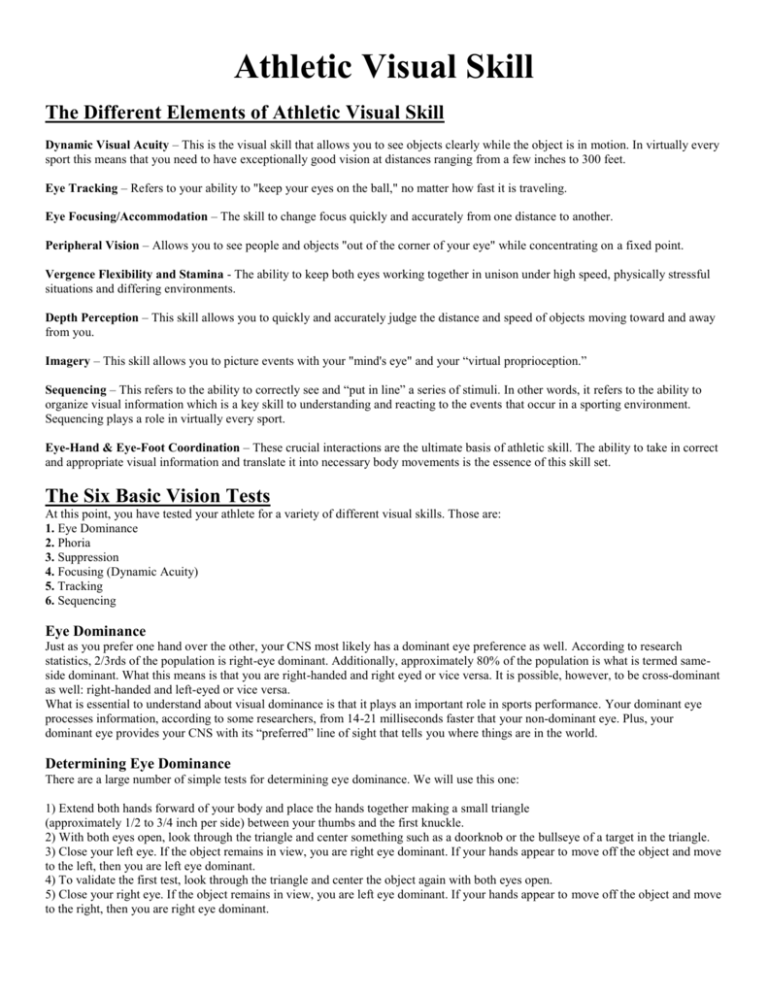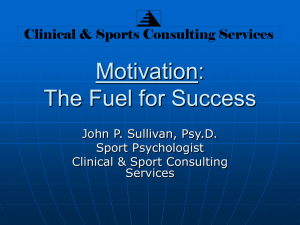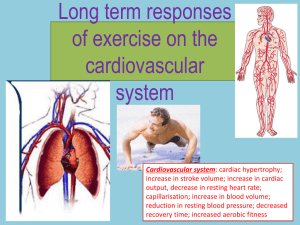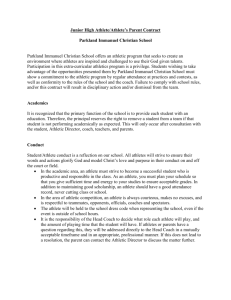
Athletic Visual Skill
The Different Elements of Athletic Visual Skill
Dynamic Visual Acuity – This is the visual skill that allows you to see objects clearly while the object is in motion. In virtually every
sport this means that you need to have exceptionally good vision at distances ranging from a few inches to 300 feet.
Eye Tracking – Refers to your ability to "keep your eyes on the ball," no matter how fast it is traveling.
Eye Focusing/Accommodation – The skill to change focus quickly and accurately from one distance to another.
Peripheral Vision – Allows you to see people and objects "out of the corner of your eye" while concentrating on a fixed point.
Vergence Flexibility and Stamina - The ability to keep both eyes working together in unison under high speed, physically stressful
situations and differing environments.
Depth Perception – This skill allows you to quickly and accurately judge the distance and speed of objects moving toward and away
from you.
Imagery – This skill allows you to picture events with your "mind's eye" and your “virtual proprioception.”
Sequencing – This refers to the ability to correctly see and “put in line” a series of stimuli. In other words, it refers to the ability to
organize visual information which is a key skill to understanding and reacting to the events that occur in a sporting environment.
Sequencing plays a role in virtually every sport.
Eye-Hand & Eye-Foot Coordination – These crucial interactions are the ultimate basis of athletic skill. The ability to take in correct
and appropriate visual information and translate it into necessary body movements is the essence of this skill set.
The Six Basic Vision Tests
At this point, you have tested your athlete for a variety of different visual skills. Those are:
1. Eye Dominance
2. Phoria
3. Suppression
4. Focusing (Dynamic Acuity)
5. Tracking
6. Sequencing
Eye Dominance
Just as you prefer one hand over the other, your CNS most likely has a dominant eye preference as well. According to research
statistics, 2/3rds of the population is right-eye dominant. Additionally, approximately 80% of the population is what is termed sameside dominant. What this means is that you are right-handed and right eyed or vice versa. It is possible, however, to be cross-dominant
as well: right-handed and left-eyed or vice versa.
What is essential to understand about visual dominance is that it plays an important role in sports performance. Your dominant eye
processes information, according to some researchers, from 14-21 milliseconds faster that your non-dominant eye. Plus, your
dominant eye provides your CNS with its “preferred” line of sight that tells you where things are in the world.
Determining Eye Dominance
There are a large number of simple tests for determining eye dominance. We will use this one:
1) Extend both hands forward of your body and place the hands together making a small triangle
(approximately 1/2 to 3/4 inch per side) between your thumbs and the first knuckle.
2) With both eyes open, look through the triangle and center something such as a doorknob or the bullseye of a target in the triangle.
3) Close your left eye. If the object remains in view, you are right eye dominant. If your hands appear to move off the object and move
to the left, then you are left eye dominant.
4) To validate the first test, look through the triangle and center the object again with both eyes open.
5) Close your right eye. If the object remains in view, you are left eye dominant. If your hands appear to move off the object and move
to the right, then you are right eye dominant.
Focusing Test: Near/Far Charts
This test uses two different letter charts to test focusing speed and flexibility at different distances.
Procedure:
1. Place the large letter chart on a wall at the farthest distance at which the athlete can still see clearly.
2. Hold the small letter chart approximately 4 inches from the athlete’s face at nose level.
3. Have the athlete read the letters from left to right alternating from the near chart to the far chart as quickly as possible.
4. Count the number of letters read in one minute.
5. Repeat two more times and average the scores.
6. Typical scores are between 60-70 letters per minute.
Tracking Test: Two-Strip Saccades
Eye tracking is a general term for measuring either the point of gaze ("where we are looking") or the motion of the eye itself relative to
the head. Most sports skills involve the ability to accurately track objects as they are in motion – “keeping your eyes on the ball.” One
component of tracking is the ability to quickly and accurately have the eyes jump from point to point in space. This is called saccadic
tracking.
Procedure
1. Attach two letter strips to the wall 3 feet apart.
2. Have the athlete stand at arm’s length from the wall.
3. Instruct the athlete to keep his/her head still during the test.
4. Have the athlete begin reading the letters beginning at the upper left column and then switching to the upper right column.
5. Count the number of letters read in one minute.
6. Repeat two more times and average the scores.
7. Typical scores are between 60-70 letters per minute.
Vergence Test: Pencil Pushups
Vergence refers to the ability for an athlete to “cross” and “uncross” the eyes accurately. This allows an athlete to maintain single
focus from near to far and far to near.
Procedure
1. Tell the athlete to keep his/her head still.
2. Hold the tip of a pencil or pen two feet in front of the athlete’s face at nose level.
3. Slowly move the tip of the pencil in until the athlete says “double” indicating he is now seeing two tips of the pencil instead of one.
4. Measure the distance between the tip of the pencil and the athlete’s nose.
5. Repeat two more times and average the measurements.
6. Most athletes should be able to avoid double vision until the pencil tip reaches their nose.
Sequencing Test
This is a different “type” of visual skill that relates to the ability to sequentially order what the eyes are seeing. This is a critical skill in
most sports!
Procedure:
1. Sit across from the athlete.
2. Using a randomized sequencing form perform the series of hand movements demonstrated. P=Palm
down on the table, S=Side of the hand down on the table, F=Fist.
3. Begin with a sequence of 3 movements.
4. Have the athlete repeat them.
5. Repeat the original 3 but add one more.
6. Have the athlete repeat.
7. Continue this until the athlete cannot complete the sequence correctly.
8. Repeat two more times and average the scores.
9. A typical score is from 6-8.
PSFFSSP
SSSFFPF
Near/Far Eye Chart Drill
The purpose of this exercise is to improve the flexibility of the visual focusing system and to be able to maintain clear vision at near
and far distances. In this exercise, you will use the small letter chart and the large letter chart.
Procedure:
1. Place a large letter chart on the wall at the maximum distance where the athlete can still clearly read it.
2. Hold the small letter chart 4 inches from the athlete’s face at nose level.
3. Read the letters from left to right, alternating between the near chart and the far chart.
Near/Far Eye Jumps – Multi-Directional
a. Up-Down
b. Diagonal
c. Combinations
The purpose of this exercise is to improve near/far focusing in multiple positions. Very few sports allow an athlete to maintain a level
gaze, instead, most sports require quick visual changes from up to down, left to right, and side to side.
Eye Tracking 3 – Number Page
Materials: Number Page, Metronome
This exercise is fantastic for increasing the accuracy of eye movements.
Procedure:
1) The coach will stand approximately 3 to 4 feet away from the athlete holding a piece of paper with the numbers one to 20 written
randomly. The numbers should be as large as possible.
2) While ensuring that the athlete remains in good posture the coach asks the athlete to focus on one of the numbers on the page. The
coach will then ask the athlete to find a different number on the paper while monitoring the athlete’s eye movements.
3) Continue through all the numbers in random order or sequentially.
4) The progression of this exercise is to increase the tempo using a metronome. You can also ask the athlete to tap their foot in rhythm
with the metronome while performing this exercise.
5) The final progression is to have the paper in motion while the athlete is performing exercise.
Two Strip Saccades
Material: 3 Strip Saccade Charts
One of the key elements of sports vision is the ability to move the eyes in what are called saccades or point-to point eye motions.
Procedure:
1) For this exercise you will be using 3 2-strip saccade letter charts and a stopwatch.
2) Place the charts on the wall approximately 3 feet apart.
3) The athlete will stand at arms length between the strips.
4) While keeping his head still the athlete will begin on the left hand upper column quickly jumping from the left to the right side
reading the letters aloud.
5) As the athlete improves, vary the distance between the charts, and the numbers of letters and size of the charts.
6) Other progressions are to read the charts in reverse order.
Hand Chasing – Direct Focus Version
This excellent exercise is adapted from the martial arts. It emphasizes the ability to utilize hand eye coordination along all the different
visual elements already trained.
Procedure:
1) Partners will stand facing one another at just under arms length distance. Beginning with one arm extended approximately halfway,
the partners will imagine that the hands are joined magnetically.
2) The leader of the drill will then begin to move in unpredictable patterns encompassing all planes of motion smoothly and slowly.
3) The follower in the drill will attempt to maintain a constant distance and position between their hands keeping a direct focus on the
leader’s hand.
4) The progression of this is to increase the speed and irregularity of the movement.
5) As much as possible the head should be kept still through the entire exercise. This will ensure that the eyes are being maximally
worked.
Hand Chasing – Peripheral Focus Version
This excellent exercise is adapted from the martial arts. It emphasizes the ability to utilize hand eye coordination along all the different
visual elements already trained.
Procedure:
1) Partners will stand facing one another at just under arms length distance. Beginning with one arm extended approximately halfway,
the partners will imagine that the hands are joined magnetically.
2) The follower of the drill will fix his eyes on his partner’s chin and attempt to “open” up his peripheral vision.
3) The leader of the drill will then begin to move in unpredictable patterns encompassing all planes of motion smoothly and slowly.
4) The follower in the drill will attempt to maintain a constant distance and position between their hands keeping a direct focus on the
leader’s hand.
5) The progression of this is to increase the speed and irregularity of the movement.
6) As much as possible the head should be kept still through the entire exercise. This will ensure that the eyes are being maximally
worked.
Vergence Exercise – Pencil Pushups
Material: Pen or Pencil, Metronome
Probably one of the most important exercise for an athlete, the pencil push-ups exercise is vital for developing eyes that work together
accurately and efficiently for sustained periods.
Procedure:
1) The athlete will sit or stand in a balanced posture.
2) Hold a pencil at arm’s length straight out and level with the athlete’s nose.
3) Fixate the eyes on the pencil point.
4) Bring the pencil in toward the nose while maintaining a single point of focus on the pencil tip.
5) The goal of this exercise is to maintain a single point focus on the pencil while bringing it within an inch of the nose.
6) The progression of this exercise is to perform in a near\far manner. In other words, it will be performed as above while periodically
looking across the room, holding for a count of four, and looking back at the pencil. The goal is to be able to look back at the pencil
without seeing double immediately.
7) Increase the difficulty of this exercise by working with a metronome.
Catching Drills with Letter Ball
Material: Marked Tennis Ball or Sport Specific Ball
These drills are intended to bring together all of the skills previously practiced. These games involve a smooth, rhythmic game of
catch between the coach and athlete using the following parameters:
1) Both Eyes
2) Alternating Eyes
3) Alternating Hands
4) Over the Shoulder
Hand/Eye & Foot/Eye Coordination Charts
Material: Coordination Charts
This exceptional exercise increases accuracy, hand-eye coordination and foot-eye coordination.
Procedure:
1) Using what are known as coordination charts (or VDP charts from sports vision), the athlete will call out which side of the line the
stars are on right, left, or middle. Use a metronome to promote this as a rhythmic activity. (Chart 1)
2) After this is mastered, the athlete taps the right-hand to indicate that the stars are on the right, taps the left to indicate the star is on
the left, and claps the hands together to indicate the star is in the middle.
3) The next progression concentrates on the feet. The athlete uses me the same procedures as above but now the square represents the
feet. (Chart 2)
4) The next progression combines movements of the hand and feet. (Chart 3)
5) This final level of the drill combines eye, hand, and foot coordination. Using the same instructions as before, use the advanced
charts which may require simultaneous taps of the foot and hand. (Chart 4)
Z-Health® Master Trainer Reference Manual
© 2009 Z-Health Performance Solutions, LLC – All rights reserved.
For Exclusive Use By Leslie Cordova-Trujillo








